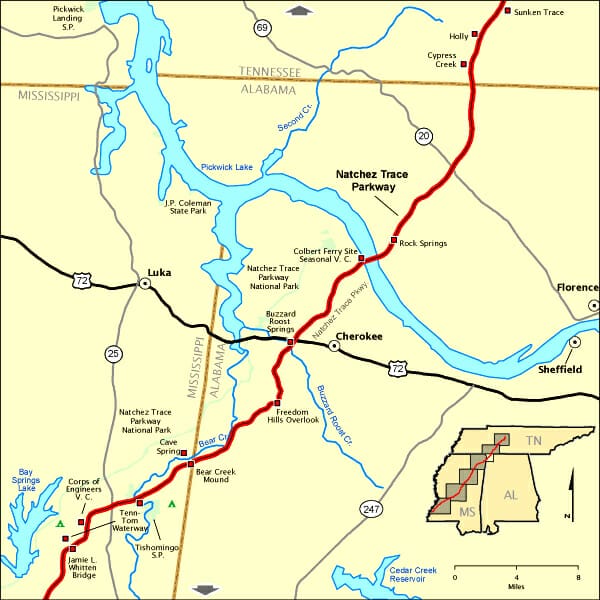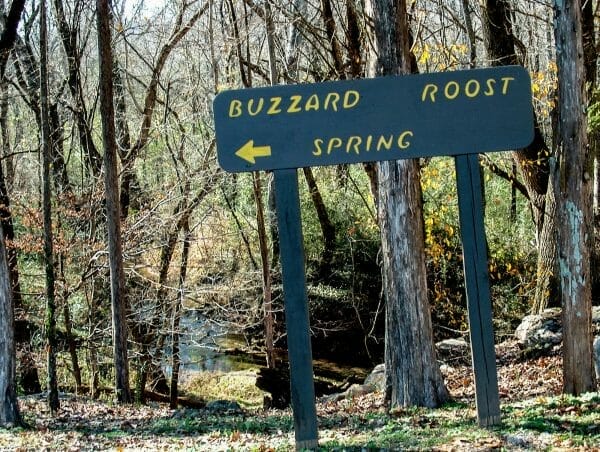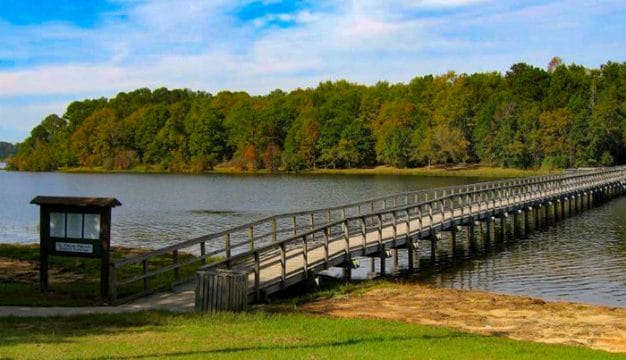Natchez Trace
 Natchez Trace in Alabama
The Natchez Trace is a prehistoric route that extended 440 miles from Nashville, Tennessee, through Alabama to Natchez, Mississippi, and provided a link between the Tennessee and Mississippi rivers. The Trace ran for about 30 miles through the northwestern part of Alabama in Lauderdale and Colbert Counties, passing through the state west of Sheffield near the town of Cherokee.
Natchez Trace in Alabama
The Natchez Trace is a prehistoric route that extended 440 miles from Nashville, Tennessee, through Alabama to Natchez, Mississippi, and provided a link between the Tennessee and Mississippi rivers. The Trace ran for about 30 miles through the northwestern part of Alabama in Lauderdale and Colbert Counties, passing through the state west of Sheffield near the town of Cherokee.
The trail became commonly known as the Natchez Trace in the late eighteenth century, but it has a long history dating back thousands of years. It was used for untold years by herds of bison and other grazing animals to move between salt licks located near Nashville and the verdant southern grasslands along the Mississippi River. This ancient trail meandered between high ridges and deep valleys, avoiding steep terrain and providing a relatively level and easy northeast-southwest route for herds migrating through the region.
Native American hunting parties took advantage of the well-worn trail and followed the “traces” of the herds. Early French explorers undoubtedly used the trail on their forays into the fertile hunting grounds along the Mississippi River. In the eighteenth century, European settlers further improved the trail, widening the foot path enough for horses and wagons to pass, and used it as a trade route and an easy passage between the Tennessee, Cumberland, and Mississippi rivers. The Natchez Trace came into more formal use in the late eighteenth century, when Pres. Thomas Jefferson, in an attempt to forestall French dominance along the Mississippi River Valley, authorized the establishment of a road through the wilderness beginning in Tennessee and ending on the banks of the Mississippi River. In 1801, the U.S. Army began improving the route, making it wide enough to be navigable by wagon.
 John Coffee Memorial Bridge
The Natchez Trace became the major trade route between the eastern states and the southern frontier. It was the only reliable land link between the eastern United States and the trading ports along the Mississippi River in Mississippi and Louisiana. As travel and trade increased, a series of inns and trading posts sprang up along the route and settlements quickly followed. Near the current town of Cherokee, the Trace crossed the Tennessee River at the mouth of Bear Creek, and Chief George Colbert, who was half Chickasaw and half Scot, operated a commercial ferry there for years. For a short period of time, the Natchez Trace was a vital part of the commerce and trade that opened the area up to settlement, but its star quickly faded. The advent of steamboats on the Mississippi River and the completion of Andrew Jackson’s Military Road in 1820, which offered a shorter route between Nashville and New Orleans, doomed the ancient route, and by 1830 it was essentially abandoned and reclaimed by wilderness.
John Coffee Memorial Bridge
The Natchez Trace became the major trade route between the eastern states and the southern frontier. It was the only reliable land link between the eastern United States and the trading ports along the Mississippi River in Mississippi and Louisiana. As travel and trade increased, a series of inns and trading posts sprang up along the route and settlements quickly followed. Near the current town of Cherokee, the Trace crossed the Tennessee River at the mouth of Bear Creek, and Chief George Colbert, who was half Chickasaw and half Scot, operated a commercial ferry there for years. For a short period of time, the Natchez Trace was a vital part of the commerce and trade that opened the area up to settlement, but its star quickly faded. The advent of steamboats on the Mississippi River and the completion of Andrew Jackson’s Military Road in 1820, which offered a shorter route between Nashville and New Orleans, doomed the ancient route, and by 1830 it was essentially abandoned and reclaimed by wilderness.
Despite its brief life span, the Natchez Trace enjoyed a lively and colorful history. This main thoroughfare to the new frontier brought all sorts of people into the area. Fur traders, shopkeepers, pioneer families, and hunters all travelled along the route, as did more unsavory characters. Worse dangers lurked on the Trace itself. Highwaymen held up travelers along the Trace and robbed nearby stores. Small bands of bandits terrorized travelers along the length of the Trace. At least two large organized gangs, one of which became known as the Mystic Clan led by John Murrell, operated for years from hideouts along the length of the Trace, and Murrell was once arrested in Florence.
One of the most famous travelers of the Trace, Meriwether Lewis of the famous Lewis and Clark Expedition, came to a mysterious and ignominious end on the Trace. Lewis was spending the night at Grinder’s Stand, an inn near the present day town of Hohenwald, Tennessee. During the night of October 10, 1809, shots were heard by the innkeeper’s wife and in the morning Lewis was found dead in his room. The details of what happened that night are murky and an investigation into his death returned a verdict of suicide. His family remained convinced that he was murdered and that the innkeeper was somehow involved.
 Buzzard Roost Spring
In the 1930s, the federal government began construction of the Natchez Trace Parkway, a limited access two-lane scenic road between Natchez and Fairview, Tennessee, near Nashville. Pres. Franklin D. Roosevelt signed legislation to create the parkway on May 18, 1938, and construction began in 1939. The current parkway encompasses more than 45,000 acres and is managed by the National Park Service, which maintains numerous historical sites along its length, including the Meriwether Lewis Museum, the Meriwether Lewis Memorial, and a visitor’s center in Tupelo, Mississippi. The route closely parallels the original Natchez Trace, and in some locations remnants of the original route may still be seen. These sections are marked with National Park Service signage and are used by modern-day hikers. The short period of time that the Natchez Trace was heavily used by settlers meant that no major cities developed along the route. As a result, the Trace remains to this day relatively undeveloped and closely resembles its original configuration.
Buzzard Roost Spring
In the 1930s, the federal government began construction of the Natchez Trace Parkway, a limited access two-lane scenic road between Natchez and Fairview, Tennessee, near Nashville. Pres. Franklin D. Roosevelt signed legislation to create the parkway on May 18, 1938, and construction began in 1939. The current parkway encompasses more than 45,000 acres and is managed by the National Park Service, which maintains numerous historical sites along its length, including the Meriwether Lewis Museum, the Meriwether Lewis Memorial, and a visitor’s center in Tupelo, Mississippi. The route closely parallels the original Natchez Trace, and in some locations remnants of the original route may still be seen. These sections are marked with National Park Service signage and are used by modern-day hikers. The short period of time that the Natchez Trace was heavily used by settlers meant that no major cities developed along the route. As a result, the Trace remains to this day relatively undeveloped and closely resembles its original configuration.
The Natchez Trace in Alabama, although short, is rich in natural beauty. It encompasses Freedom Hills Overlook, at 800 feet the highest point of the Trace in Alabama; Rock Springs, a natural spring that attracts thousands of hummingbirds on their annual migrations; Buzzard Roost Springs, which features an exhibit telling the story of Chickasaw chief Levi Colbert; and Colbert Ferry, where George Colbert reportedly charged Andrew Jackson $75,000 for ferry services.
Further Reading
- Bachleda, F. Lynne. Guide to the Natchez Trace Parkway. Birmingham, Ala.: Menasha Ridge Press, 2005.
- Daniels, Jonathan. The Devil’s Backbone: Story of the Natchez Trace. 1962. Reprint, Gretna, La.: Pelican Publishing, 1998.
- Davis, William. A Way Through the Wilderness: The Natchez Trace and the Civilization of the Southern Frontier. New York: HarperCollins, 1995.



